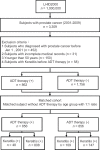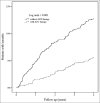Androgen deprivation therapy and the risk of subsequent keratitis
- PMID: 33505879
- PMCID: PMC7821820
- DOI: 10.4103/tcmj.tcmj_31_20
Androgen deprivation therapy and the risk of subsequent keratitis
Abstract
Objectives: The objective of the study was to determine the risk of subsequent keratitis in prostate cancer (PCa) patients treated with androgen deprivation therapy (ADT).
Materials and methods: Three thousand three hundred and nine patients with PCa were identified using data from Taiwan's National Health Insurance Research Database for 2001 through 2013. Among those patients, 856 treated with ADT comprised the study group, while 856 non-ADT-treated patients matched with 1:1 propensity-score-matched analysis comprised the control group. The demographic characteristics and comorbidities of all the patients were analyzed, and Cox proportional hazards regression was utilized to determine the hazard ratios (HRs) for subsequent keratitis.
Results: A total of 157 (9.2%) patients had newly diagnosed keratitis. Compared to the non-ADT-treated patients, the ADT-treated patients had a reduced risk of subsequent keratitis, with an adjusted HR of 0.38 (95% confidence interval: 0.27-0.55; P < 0.001).
Conclusion: ADT treatment apparently decreased the risk of subsequent keratitis in the investigated PCa patients, but the clinical significance of this finding should be further assessed in additional studies.
Keywords: Androgen deprivation therapy; Keratitis; Prostate cancer.
Copyright: © 2020 Tzu Chi Medical Journal.
Conflict of interest statement
There are no conflicts of interest.
Figures
References
-
- Siegel RL, Miller KD, Jemal A. Cancer statistics, 2017. CA Cancer J Clin. 2017;67:7–30. - PubMed
-
- Huggins C, Hodges CV. Studies on prostatic cancer. I. The effect of castration, of estrogen and androgen injection on serum phosphatases in metastatic carcinoma of the prostate. CA Cancer J Clin. 1972;22:232–40. - PubMed
-
- Shahani S, Braga-Basaria M, Basaria S. Androgen deprivation therapy in prostate cancer and metabolic risk for atherosclerosis. J Clin Endocrinol Metab. 2008;93:2042–9. - PubMed
-
- Galvão DA, Taaffe DR, Spry N, Joseph D, Newton RU. Cardiovascular and metabolic complications during androgen deprivation: Exercise as a potential countermeasure. Prostate Cancer Prostatic Dis. 2009;12:233–40. - PubMed
-
- Wu CT, Yang YH, Chen PC, Chen MF, Chen WC. Androgen deprivation increases the risk of fracture in prostate cancer patients: A population-based study in Chinese patients. Osteoporos Int. 2015;26:2281–90. - PubMed
Publication types
LinkOut - more resources
Full Text Sources
Other Literature Sources


